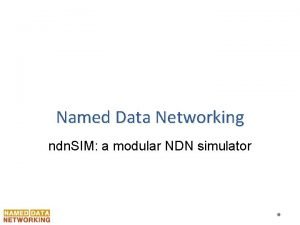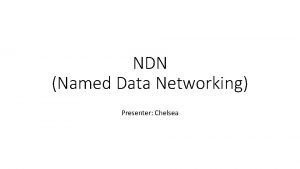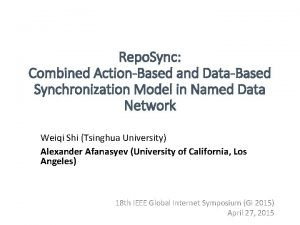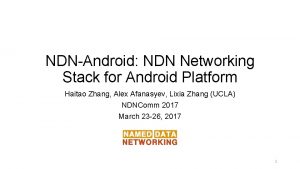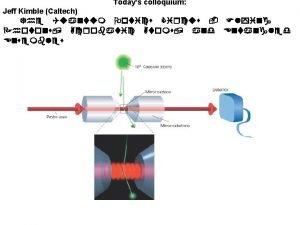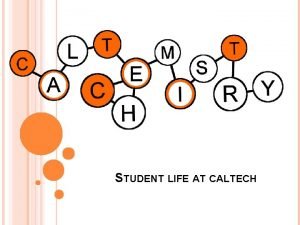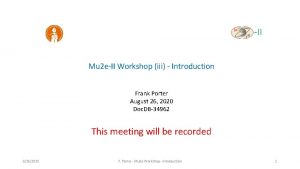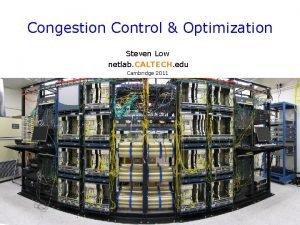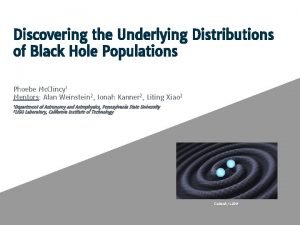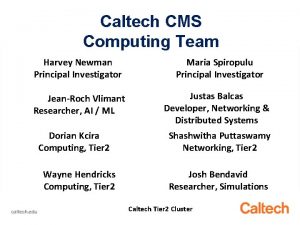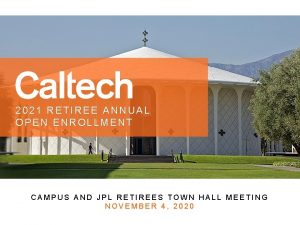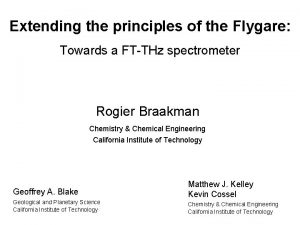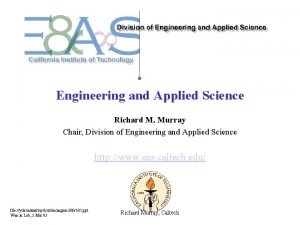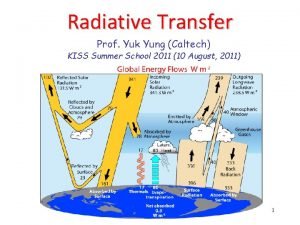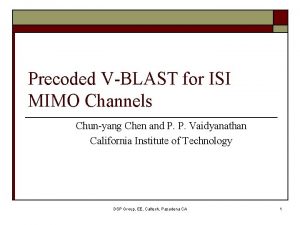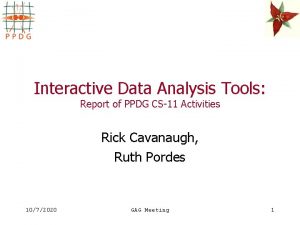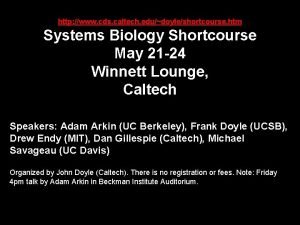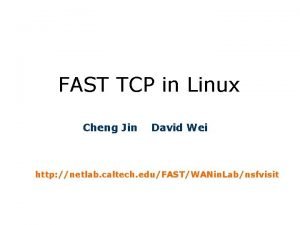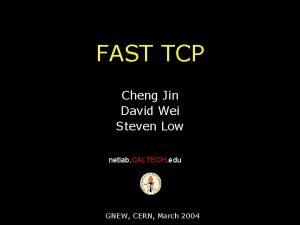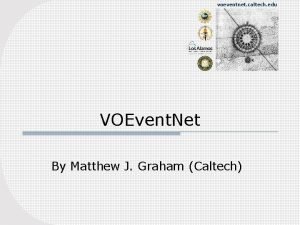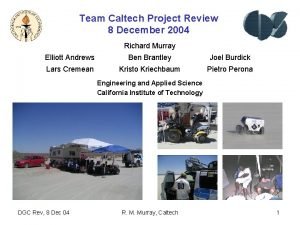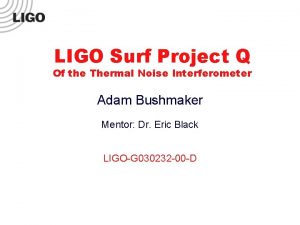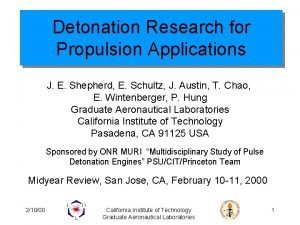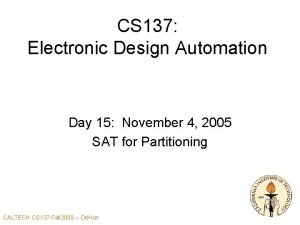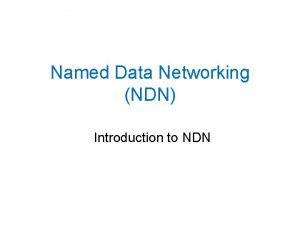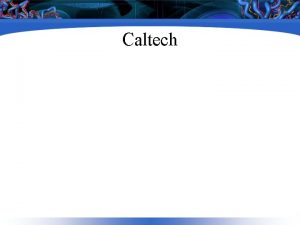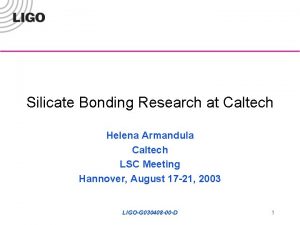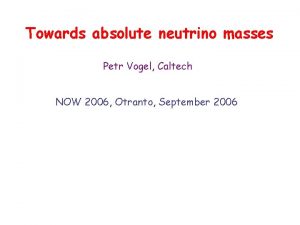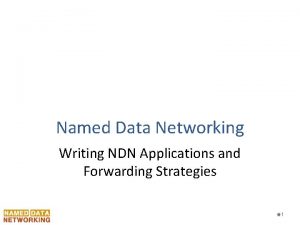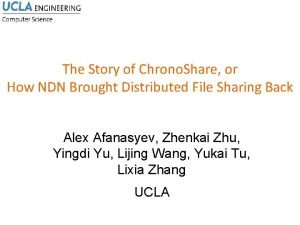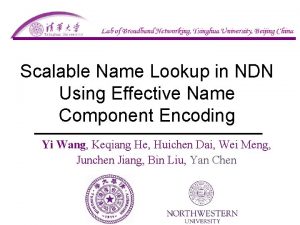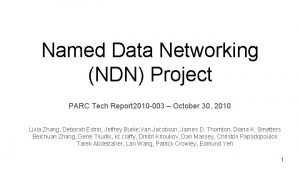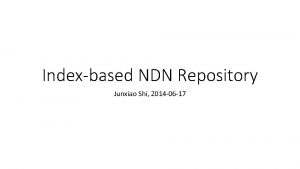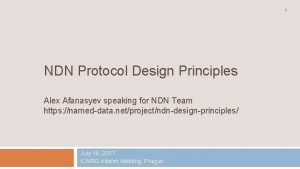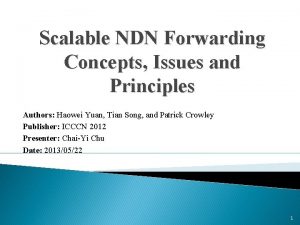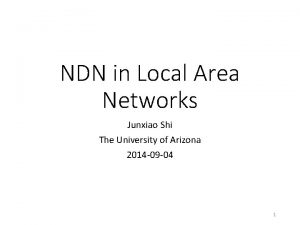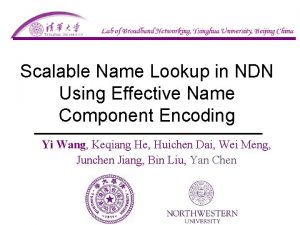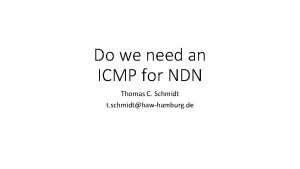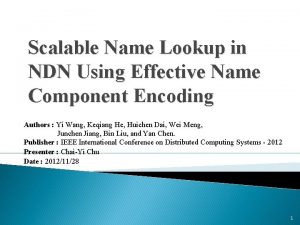NDN Day at Caltech Towards an RD Program


















![NDN Day at CERN: July 6, 2015 Colorado State, Imperial and Caltech Groups [2] NDN Day at CERN: July 6, 2015 Colorado State, Imperial and Caltech Groups [2]](https://slidetodoc.com/presentation_image_h/312b8873319ce54c20fbc96801c9efa9/image-19.jpg)
![NDN Day at CERN: July 6, 2015 Colorado State, Imperial and Caltech Groups [2] NDN Day at CERN: July 6, 2015 Colorado State, Imperial and Caltech Groups [2]](https://slidetodoc.com/presentation_image_h/312b8873319ce54c20fbc96801c9efa9/image-20.jpg)
![NDN Day at CERN: July 6, 2015 Colorado State, Imperial and Caltech Groups [3] NDN Day at CERN: July 6, 2015 Colorado State, Imperial and Caltech Groups [3]](https://slidetodoc.com/presentation_image_h/312b8873319ce54c20fbc96801c9efa9/image-21.jpg)
![NDN Day at CERN: July 6, 2015 Colorado State, Imperial and Caltech Groups [4] NDN Day at CERN: July 6, 2015 Colorado State, Imperial and Caltech Groups [4]](https://slidetodoc.com/presentation_image_h/312b8873319ce54c20fbc96801c9efa9/image-22.jpg)









- Slides: 31

NDN Day at Caltech: Towards an R&D Program for CMS, HEP and Data Intensive Sciences § NDN: a content-focused future internet architecture § A decade of R&D, study and optimization [Lixia, Edmund] § Climate Science: A data intensive example [Christos] § A promising approach to improve CMS workflow § Explore the fit to two CMS use cases: Analysis, Production § Identify CMS & LHC issues § SANDIE (NSF): SDN assisted NDN for LHC-scale use cases § Goal of the Day: Launch an NDN R&D program in CMS Harvey B Newman NDN Day: Introduction and Perspective November 20 2017

Named Data Networking (NDN) r NDN is a novel architecture, and a leading project among five originally funded by the NSF’s Future Internet Architecture Program r Precursor (2006): Content-Centric Networking (CCN) r NDN data is named and secured, making it location agnostic r Parallels CMS’ orientation towards location-independent data access (with Xroot. D) r NDN addresses the mismatch between r The location-centric (source-destination) nature of the current Internet that arose when communcations were dominated by telephony, and one to one conversations r The needs of applications and users: that are focused on the content; the “what” and not the “where” r NDN’s architecture and implementation: responds to the successes of the narrow waist model of the Internet r That has enabled it to expand worldwide, and become the principal means of human & interprocess communication r Handling all types of information: from email to music to video to binary to semantic data 2

LHC Experiments’ Workflow and NDN r LHC experimental data is transferred to sites using two main methods: 1. Pre-placement using data movement orchestrators such as Ph. EDEx (CMS) and Rucio (ATLAS) 2. Remote access from federated storage using the XRoot. D protocol e. g. AAA (CMS) and FAX (ATLAS) § There is currently no caching r Overall solutions have evolved into a complex software overlay r Substantial effort in monitoring and support r Named Data Networking (NDN) offers an interesting possibility of a simpler approach r No attempt is made to predict data popularity; popularity emerges r Every attempt is made to cache data once it has been actually requested r NDN’s paradigm, requesting data by name rather than location parallels CMS’ orientation towards location-independent data access (with Xroot. D) 3

Names and Caching in NDN r “NDN changes the semantics of network service from delivering the packet to a given destination address to fetching data identified by a given name” r No restrictions are imposed on the naming scheme r The names uniquely identify an object or collection: a data chunk in a file, an end-point, an instance; a characteristic, condition, heritage, environment, etc. r A hierarchical directory-like naming structure is useful for understanding, order, scalability; “/” are used as delimiters r CMS named example (via HEP to NDN Translator by Christos with Jean-Roch): /store/mc/fall 13/Bprime_M_3000 / GEN-SIM/POSTLS 162_v 1 v 2/10000/001. root r Crucially, as data packets traverse the network they are cached in (software) routers r It is the caching of data that should reduce latency and network use r Data are secured by requiring producers to 4 cryptographically sign each data packet

NDN Data Delivery Requests, Routing and Caching r Communication driven by the receivers: “I want data object or collection X” r A consumer, interested in a named data item or collection, sends out a request to the network in the form of a ‘virtual interest packet’ (VIP) r As the interest packet is routed towards a copy of the data r A check is made to see if that router has a copy of the segment in its Content Store (cache). r If it does: the router serves the data back to the interface that the interest packet came from r If Not: it is stored in the NDN router's Pending Interest Table (PIT) and the interest packet is forwarded until it reaches a copy of the desired data, or the longest match by name (from the left) r The resulting collection of PIT entries acts as a 'trail of crumbs' for the data packet to follow back to the consumer [i. e. symmetric routing] r If two consumers request the same data segment from a router only one interest packet is forwarded r The forwarding strategy is programmable r e. g. it is possible to send interest packets to multiple routers r if one route fails the data can be served by the second one, 5 thereby building in reliability

Named data networking (NDN) R. Voicu, GLIF Meeting 2015 Two types of packets: q Interest – consumer puts the name and sends it q Data – contains both matched name and the content q Digital signatures for packets q q NDN routers maintain three tables and a Forwarding Strategy(FS): q Pending Interest Table(PIT) – forwarded requests q Forwarding information base (FIB) – routing table q Content Store (CS) – local router cache q Forwarding Strategy (FS) – policies and rules about forwarding Software and more resources: NDN Collaboration (http: //named-data. net): q NFD (Networking Forwarding Daemon) q NDN libraries for the client software

NDN Content Store(CS) and Repository CS/Repository servers for NDN CS Cache (1 U server): 100 G NIC + NVMe SSDs Repository: 2 U-4 U server with SAS disk arrays for persistent data; 40 -100 G NIC; SSDs optional (due to cost) q CEPH file system instance q + Large memory FS cache q DTNs designed by Caltech, UCSD good candidates q q

NDN & Virtual Interest Packets (VIP) Edmund Yeh Northeastern University NDN allows combined Forwarding Strategy and Caching to optimally utilize bandwidth and storage q VIP Algorithm (ACM ICN 2014): q On top of an existing NDN infrastructure q New metric which captures the measured demand for the respective data objects in the network q Maximizes data delivered by network q Load balancing is achieved via multipath forwarding and dynamic caching q Superior delay performance results q Optimally trades off link bandwidth with storage I/O bandwidth q Allows data chunks of one object to use same path q Can incorporate congestion control at request nodes q

Early NDN Activities q q q q NADIS proposal to NSF 2014 (Caltech and NEU) Designed in-network and edge caching servers Mapped CMS dataset names to an NDN structure (Christos and Jean-Roch) Joined the NDN testbed led by Christos at Colorado State We looked at ROOT plugin (NDN client library) developed by D. Colling, D. Fayer at IC London [cf. CHEP 2015] NDN Day at CERN (Caltech, CSU, NEU, IC London) July 6, 2015 q Focus on Data Intensive NDN and potential role of SDN Updated Map, Model for simulation models studying advantage of edge and core (in-network) caches (Yeh and Liu, Northeastern) SANDIE Proposal to NSF (NEU, CSU, Caltech) Submitted 8/2016; Awarded 3/2017

Xroot. D under NDN christos@colostate. ed No manager, fewer steps, more robust 1010

Science NDN Testbed christos@colostate. edu NSF CC-NIE campus infrastructure award 10 G testbed (courtesy of ESnet, UCAR, and CSU Research LAN) Currently ~50 TB of CMIP 5, ~20 TB of HEP data 11

NSF Campus Cyberinfrastructure and Cybersecurity Innovation for Cyberinfrastructure PI Workshop October 3 -4, 2017 Albuquerque, New Mexico Program, Area: CC, Integration Award Number: 1659403 PI: Edmund Yeh co-PIs: Harvey Newman, Christos Papadopoulos Project Title: SANDIE: SDN-Assisted NDN for Data Intensive Experiments Edmund Yeh Professor Northeastern University eyeh@ece. neu. edu Harvey Newman Professor of Physics Caltech newman@hep. caltech. edu Christos Papadopoulos Professor Colorado State University christos@colostate. edu

NSF Campus Cyberinfrastructure and Cybersecurity Innovation for Cyberinfrastructure PI Workshop October 3 -4, 2017 | Albuquerque, NM CC* Integration: SANDIE: SDN Assisted NDN for Data Intensive Experiments CHALLENGES § LHC program in HEP is world’s largest data intensive application: handling One Exabyte by ~2018 at hundreds of sites § Global data distribution, processing, access, analysis; large but limited computing, storage, network resources APPROACH § Use Named Data Networking (NDN) to prototype a redesigned LHC HEP network; aim to optimize workflow SOLUTIONS + Deliverables § Deploy NDN edge caches with SSDs & 40 G/100 G network interfaces at 7 sites; combine with larger core caches § Develop naming scheme and attributes for fast access and efficient communication in HEP and other fields § Simultaneously optimize caching (“hot” datasets), forwarding, and congestion control in both the network core and site edges SCIENTIFIC and BROADER IMPACT § Lay groundwork for an NDN-based data distribution and access system for data-intensive science fields § Benefit user community through lowered costs, faster data access and standardized naming structures § Engage next generation of scientists in emerging concepts of future Internet architectures for data intensive applications § Advance, extend and test the NDN paradigm to encompass the most data intensive research applications of global extent TEAM § Northeastern § Caltech § Colorado State § In partnership with other LHC sites and the NDN project team

SANDIE: SDN Assisted NDN for Data Intensive Experiments r Goal: Extend the use of NDN to the most data intensive experiments r Start with CMS: Analysis with Mini. AOD, Nano. AOD, Scouting datasets; Production dataset delivery; + Study of the LSST use case r Leverage: r Developments and experience with ESGF; NDN testbed; naming studies (CSU) r Optimal adaptive routing and caching algorithms (NEU and UCLA) r 1 st first comprehensive approach to jointly optimizing caching, multipath forwarding, and congestion control in NDN networks (NEU) r High throughput, DTN designs, file system and data access R&D, SDN controllers, dynamic circuits; consistent operations (Caltech) r Products: FDT, ODL controller w/ALTO, OVS and Fire. Qo. S plugins; Tier 2 with CEPH R&D instances; Multiswitch and multi-DTN SDN Testbed r Methodology: (1) Create an overlay network among selected CMS sites with caches + repositories: Caltech, UCSD, Northeastern; Nebraska, MIT, Florida, CERN, etc. (2) Optimally allocate bandwidth, select or create paths; load balance among multiple large flows across complex networks (3) Provide stable FDT flows at defined rates combined with protocol independent control methods: at the sites (e. g. with OVS) and in the network core (e. g. ALTO) 14

SANDIE: SDN Assisted NDN Problems to be addressed in this research project r Integration of the above methods and tools with the mainstream data production and analysis tools of CMS r Using the results of the project for CMS to derive an NDN-based operational model for data analysis that would benefit other major programs (ATLAS, LSST, SKA) r Optimization of data distribution and access performance in a highly distributed petabyte-scale storage and computing system r Network core and edge node design and performance optimization r Development of appropriate naming schemes and attributes for fast access and efficient communication in HEP & other data intensive fields r Scalability of the NDN system in both the amount and types of data supported (e. g. Nano. AOD “flavors”, byte ranges, non-event data) and its geographical extent r Adaptation of NDN to take advantage of SDN-enabled infrastructures: as a function of scale Downstream Goal: Extend the use of NDN to the most data intensive experiments, with SDN 15

A Short List of Data Intensive NDN Issues As a function of transaction time, scale and scope r Levels of data intensive transactions: Which are “in scope” ? 1. Completed on the fly [1 to 100 Gbytes] in seconds to a couple of minutes 2. Completed in < 15 minutes [0. 1 to 1 Tbytes]: get a small dataset 3. Completed in a few hours: need to prepare the network and/or storage; plan and/or queue and/or prioritize requests 4. Longer/Larger transactions: authorized personnel with key roles only r What is the scope of “reasonable requests” ? r What is our strategy to determine/limit which requests are in scope ? Is there negotiation between the user and the “system” ? How are users guided to make (only) requests that can be satisfied ? r How are requests orchestrated/prioritized, given limited resources ? r Are transactions in each class (1 to 4 above) handled with different strategies? r How is “our” NDN system crafted to handle each transaction level ? r When/where does SDN come in: dynamic circuits, path selection, flow control ? r What storage I/O and network performance levels do we require for success ? r What are the CPU needs & hardware configuration of the NDN routers ? Note we are dealing with software (versus hardware/ASICs in traditional routers) r What are effective strategies for our case of: (1) caching (2) forwarding and (3) congestion control; How are these modified for long/large transactions ? 16

NDN Day at Caltech: Towards an R&D Program for CMS, HEP and Data Intensive Sciences § NDN: a content-focused future internet architecture § A decade of R&D, study and optimization [Lixia, Edmund] § Climate Science: A data intensive example [Christos] § A promising approach to improve CMS workflow § Explore the fit to two CMS use cases: Analysis, Production § Identify CMS & LHC issues § SANDIE (NSF): SDN assisted NDN for LHC-scale use cases Goal of the Day: Launch an NDN R&D program in CMS WLCG ESGF

NDN Day at Caltech: November 20, 2017 Backup Slides Follow 18
![NDN Day at CERN July 6 2015 Colorado State Imperial and Caltech Groups 2 NDN Day at CERN: July 6, 2015 Colorado State, Imperial and Caltech Groups [2]](https://slidetodoc.com/presentation_image_h/312b8873319ce54c20fbc96801c9efa9/image-19.jpg)
NDN Day at CERN: July 6, 2015 Colorado State, Imperial and Caltech Groups [2] r 1: 30 - 3: 00 PM: Introductions and Q&A (Christos, David, Edmund, HN, Jean-Roch, Ramiro, Iosif) Points to cover: r What interests you in NDN, or what is your role in NDN development and use ? r What are your near term plans for NDN ? r What are your longer term plans ? Do these include production use; in CMS for example ? r What do you consider the main challenges ? r [Ramiro, Julian, Iosif, Azher, Edmund, HN]: How do you see the potential to combine SDN and NDN for data intensive applications ? r 3: 00 - 3: 45 Talk by Christos on the status and outlook for NDN activities at Colorado State; issues for the HEP use case (30' + 15') [People at Caltech join at 6 AM Pacific Time] 19
![NDN Day at CERN July 6 2015 Colorado State Imperial and Caltech Groups 2 NDN Day at CERN: July 6, 2015 Colorado State, Imperial and Caltech Groups [2]](https://slidetodoc.com/presentation_image_h/312b8873319ce54c20fbc96801c9efa9/image-20.jpg)
NDN Day at CERN: July 6, 2015 Colorado State, Imperial and Caltech Groups [2] r 3: 45 - 4: 30 PM Talk by David Colling and Demonstration of the Root Plugin by the group at Imperial r 4: 30 - 5: 00 PM Recap of the status and Issues so far r 5: 00 – 5: 30 PM Key issues and next steps before David has to go. [Or - can someone take him to the airport a little later ? ] r 5: 30 – 6: 30 PM [Shall we go longer after 8 PM if needed. . . ok ? ] In-depth discussion and action items: r Consequences of the data intensiveness of the HEP use case; recall various parts of the HEP workflow using the WLCG dashboard r Caching and latencies: how much data, where and when ? Time to deliver ? r Naming and prototype setups: r We already have an example of naming from Jean-Roch; r How to get some datasets (or at least the structure and dummy data ? ) set up on the Colorado State testbed. r Which kinds of operations do we want to emulate: Including event selection ? Object Selection ? r Can we use the Imperial Root plugin for this ? 20
![NDN Day at CERN July 6 2015 Colorado State Imperial and Caltech Groups 3 NDN Day at CERN: July 6, 2015 Colorado State, Imperial and Caltech Groups [3]](https://slidetodoc.com/presentation_image_h/312b8873319ce54c20fbc96801c9efa9/image-21.jpg)
NDN Day at CERN: July 6, 2015 Colorado State, Imperial and Caltech Groups [3] r 6: 30 PM Testbed setup; Operational plans and issues r Can we make a distributed testbed among Caltech, Colorado State, CERN and Imperial ? Other sites (Northeastern, Starlight, etc. ) ? r What about scaling this up to 40 G and then 100 G for 2 -3 sites ? r What are the major object-collection and file (and file system) related issues for NDN) ? r What about the file system, for example ceph (object and file views, high performance, virtualization etc. ) r How will this complement Xroot. D ? Will it replace it [if not already answered ? r What about Open v. Switch and high throughput transfers with Qo. S ? (related to the SDN/NDN intersection) r 7: 00 PM – remarks from Edmund on NDN at Northeastern r 7: 30 PM+: If time permits: Outlook for production; How this might intersect with CMS workflow 21
![NDN Day at CERN July 6 2015 Colorado State Imperial and Caltech Groups 4 NDN Day at CERN: July 6, 2015 Colorado State, Imperial and Caltech Groups [4]](https://slidetodoc.com/presentation_image_h/312b8873319ce54c20fbc96801c9efa9/image-22.jpg)
NDN Day at CERN: July 6, 2015 Colorado State, Imperial and Caltech Groups [4] r 7: 30 PM+ Outlook for production: How might this intersect with CMS workflow: r For analysis: Root plugin r Use with Ph. EDEx and dynamic circuits: dynamic dataset placement r also perhaps together with Open v. Switch) r Use with ASO ? : placing batch job outputs (at several to tens of Hz) 22

Location Independent Access: Blurring the Boundaries Among Sites + Analysis vs Computing Maria Girone, CMS Computing (2015) § Once the archival functions are separated from the Tier-1 sites, the functional difference between Tier-1 and Tier-2 sites becomes small [and the analysis/computing-ops boundary blurs] § Connections and functions of sites are defined by their capability, including the network! Tier-0 Tier-2 Tier-1 Tier-2 CAF Tier-1 Tier-2 + Elastic access from some Tier 2/Tier 3 sites

NDN realisation • N D N c ollabora tion (http : //na m e d-da ta. ne t) – “ A C olla borative E ffort to P rom ote a nd S usta in the N D N F uture Internet Arc hitecture” – “ It a ims to provide a practic a lly de ploya ble se t of protocols replacing TC P /IP tha t increa ses ne twork trustworthiness a nd se curity, addresse s the g rowing bandwidth requireme nts of m ode rn conte nt, and sim plifies the cre a tion of sophistic a te d distribute d a pplic a tions. ” • Produc e N D N pla tform with ndn-c xx libra ry a nd N a m e d D a ta N e tworking Forw arding D a e mon (N F D ) • N F D ha ndles N D N pac ket tra nsfe rs a nd a c ts a s N D N route r • Availa ble for U buntu a nd M a c O S X • We ha ve built N F D R P M s for C e nt. O S 7 , our pre fe rre d distribution D. Collng at CHEP 2015 2

Repository • Alon g with data c hing in route rs N D N ha s the c once pt of a m ore perm a nent store known a s a re pository • We ha ve writte n a pplication in C + + to provide re pository se rvice s c a lle d re po-se ('re pose ') • Applic a tion links a g a inst lib-ndnc xx to c onnec t it to N D N a nd to b ac kend filesyste m libra ries libra dos (pa rt of C e ph) & libcurl • B a c kends a llow file s to b e se rved into the N D N na m e space from e ithe r a c onve ntiona l PO S IX filesyste m , C e ph or H TTP sourc e • D e sign e d with sc a la bility in m ind 2

Repository client • S m all sta tic c lien t libra ry, libre poc lien t, is a lso inc lud ed within the re pose c od eb a se – provid es a m inim al P O S IX -like inte rfa c e (open (), re a d(), c lose(), . . . ) an d is d esig n ed to b e linke d in to sha red lib ra ry plu g ins for othe r a pplic a tions suc h a s R O O T & G FA L 2 A lso a m in im a l " g e tfile" a pplic a tion for te sting , which fe tch e s a n • en tire file from N D N a nd write s it to th e loc a l disk using th e c lien t libra ry C u rre nt im p lem e nta tion is lim ite d to re a d-only a c c e ss for • b a sic d em onstra tion s a n d te stin g O nc e we fina lise a plan for a uthe ntic a tion it c an the n b e • e xte nd ed to in c lud e full rem ote I/O (re a d-write) O rig in a l ve rsion of c lie nt req ue ste d a n d re trieve d d a ta • se g m e nts one a tim e C u re ntly working on im p rovin g the c lie nt to se nd ou t • m ultiple in te re st p a c ke ts sim ulta ne ously 2

IC HEP NDN testbed • Insta lle d a n N D N testbe d runnin g N F D software com prisin g : – a U se r Interfa ce host – two N D N routers – two repositorie s running 'repo-se' for data storag e – C eph c luste r storag e with four 16 TB se rve rs • R outing paths a re a dded in m a nua lly, e. g. nfdc reg iste r /de m o/rados udp 4: //123. 1 23 • The clie nt on the U I re quests da ta se g m e nts from the re po-se by se ndin g out intere st pack ets to the inte rm e dia te route rs • The pa ssa g e of the inte rest pa ckets a nd returnin g da ta pa c kets c a n be monitored using the 'ndndu m p' software (https: //g ithub. com/zhe nkai/ndndu m p) • C urre ntly usin g te stbe d to build up e xpe rie nce with N D N 2

ROOT plugin • R O O T is an inte g ra l pa rt of m ost H E P e xpe rime nt a nalysis software • We have code d up a prototype N D N R O O T plug in usin g C + + • O n the N D N te stbe d w e a re now a ble to ope n a R O O T file stored in our C eph c luste r from the N D N U I via an N D N route r • It is cu rrently unoptimise d a nd ra ther slow 2

Grid testing • Te stb ed N F D softw are use s C e nt. O S 7 but our g rid c luste r worker node s a re running C e nt. O S 6 • We ha ve built the N F D softw are on C e nt. O S 6 for g rid te sting • S ubm it g rid jobs to our production c luste r which inc lude a ta rb all of the N D N softwa re in the input sa ndbox – in future will use C V M F S softw are a • S uc h jobs a re a ble to sta g e a file from the re pository to the W N loc a l disk • Pla n to te st a t sc a le with a w ell-re sourc e d host a c ting a s a n N D N co re route r • Would a lso like to te st re a ding a nd c a c hing of R O O T file s over long e r dista nc e s 29

• Possible use with LHC VO M a in use c a se is ch aotic u se r an alysis where it is difficu lt to predic t wha t data is to be re a d • A ve rsion of the experim e nt's a na lysis co de would be built with the N D N R O O T plug in • V O da ta se ts c ould be en crypte d using a n individual sym m etric ke y per da ta set • Ac c e ssing the da ta would involve two ste ps, the c lien t would – re quest the en c rypte d da ta – re quest the en c ryption key from a D ata S e t Key S erve r (D S K S ) with a sig ne d interest pa c ke t • The ke y serve r would ch e ck the use r's m em be rship of the V O an d if va lid would e ncrypt the da ta se t key with the user's public key a nd sen d it ba ck • O n re c eipt of the en c rypte d key a nd da ta pa ck ets the a pplic ation would de c rypt the ke y with user's private key an d use that to a c c e ss the data 30

Scalable routers • N D N route rs m e ntione d in the lite ra ture disc uss the c a ch ing of data in m e mory • With L H C e xperim e nt R O O T file s rou g hly 2 G B in size a nd inc re a sing , the via bility of suc h in-m e mory c a c hing is que stion able • We e nvisa g e the nee d to build a sc a lable route r sim ila r to our sc a la ble re pository • The route r would like ly h ave se vera l la yers of c a c hing : – M e m c a c hed – SSD – C e ph b ase stora g e • M a y e nd up with a hybrid route r-re pository a t e xperim e nt site s 31
 Day 1 day 2 day 3 day 4
Day 1 day 2 day 3 day 4 Ndn mode
Ndn mode Ndn
Ndn Ndn
Ndn What is network stack android
What is network stack android Ndn
Ndn Day 1 day 2 day 817
Day 1 day 2 day 817 Towards independence commerce program
Towards independence commerce program Jeff kimble caltech
Jeff kimble caltech Caltech student life
Caltech student life Richard feynman caltech
Richard feynman caltech Frank porter caltech
Frank porter caltech Caltech bursar
Caltech bursar Steven low caltech
Steven low caltech Shreya anand caltech
Shreya anand caltech Harvey newman caltech
Harvey newman caltech 877-644-1774
877-644-1774 Christina cohen caltech
Christina cohen caltech Frank rice caltech
Frank rice caltech Richard murray caltech
Richard murray caltech Yuk yung caltech
Yuk yung caltech Lei chen caltech
Lei chen caltech Cs11 team
Cs11 team Cds caltech
Cds caltech David jin caltech
David jin caltech David jin caltech
David jin caltech Matthew graham caltech
Matthew graham caltech Richard murray caltech
Richard murray caltech Caltech ligo surf
Caltech ligo surf Joe shepherd caltech
Joe shepherd caltech Caltech
Caltech Richard ellis caltech
Richard ellis caltech

